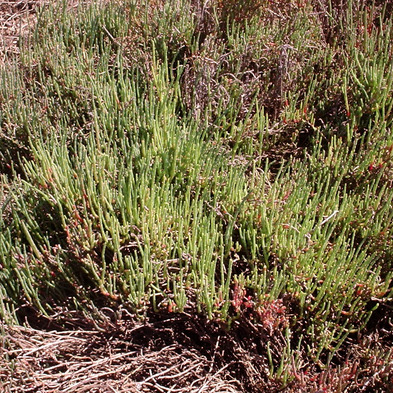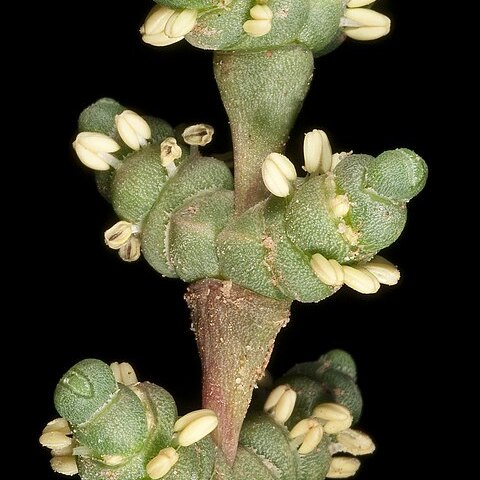Glabrous shrubs or herbs. Branches when young with globose to cylindrical segments or articles (internodes); segments succulent, the outer portion eventually shrivelling and falling, the apex shortly cup-shaped or bilobed representing the reduced opposite leaves; sclereids absent from pallisade tissue. Inflorescence a spike-like thyrse usually terminal to a branchlet, consisting of triads of flowers (cymes) in the axil of each bract (in H. pluriflora up to 7 flowers in a cyme). Opposite bracts united or rarely free, succulent. Flowers sessile, usually bisexual but the stamens or ovary sometimes not developed, in some variants only female. Perianth gamotepalous, initially membranous or succulent; lobes 3 (2 lateral and a medial abaxial). Stamen 1, abaxial. Ovary vertical, membranous or succulent; style slender, 2(3)-lobed. Fruiting perianth membranous, succulent, spongy, pithy, crustaceous, or corneous. Seed ovoid to circular; testa membranous to crustaceous; embryo curved; perisperm abundant, lateral.
Glabrous annual or short-lived perennial plants, appearing leafless. Branches of cylindrical segments of articles (internodes); segments succulent, the apex very shortly bilobed, the lobes representing the reduced opposite leaves; sclereids absent. Inflorescence a terminal or lateral spike-like thyrse consisting of 3–5 flowers in the axils of opposite and decussate free or almost free bracts. Flowers sessile bisexual, vertical to spike axis and concealed within bracts. Perianth succulent, of 2 laterally placed plano-convex tepals. Stamen solitary, abaxial. Ovary thin-walled; style slender, 2-lobed. Fruiting perianth; tepals free, areolate and hyaline when dry; pericarp membranous. Seed bluntly ellipsoidal to lenticular; testa coriaceous; embryo curved, on adaxial side of seed; perisperm abundant, lateral. Seed dispersed on the disintegration of spike, perianth, and pericarp.
Shrubs, appearing leafless, glabrous. Branches when young of cylindrical to spherical segments or articles (internodes) that are cup-shaped to 2-lobed at apex; segments succulent, the outer portion eventually shrivelling and deciduous. Inflorescence either a spike-like thyrse consisting of triads of flowers (cymes) immersed in the axil of each fleshy bract, or of triads dispersed among the branch segments. Flowers dimorphic: central flower of triad bisexual, the laterals male. Perianth gamotepalous membranous or succulent. Stigmas 2, narrowly triangular. Fruit: perianth membranous, succulent or shrivelled; pericarp firmly crustaceous or woody. Seed ovoid; testa thin; embryo straight or curved, radicle inferior; cotyledons conduplicate; perisperm copious lateral.
Dwarf shrubs with cylindrical succulent stems. Leaves opposite, represented by short fleshy spurs apparently decurrent along internode. Infloresence a spike-like thyrse consisting of triads of flowers in the axils of opposite decurrent bracts. Flowers dimorphic, the lateral male and the central bisexual. Perianth gamotepalous, membranous, scarcely changed in fruit. Stamen 1, abaxial in central flower. Stigmas narrowly triangular. Fruit: pericarp hard, fused to and sunken into woody spike axis. Seed orbicular; testa thin; embryo annular; perisperm central.
Glabrous herbaceous perennials, dioecious. Branches appearing jointed with the opposite leaves enveloping the stem in a succulent, sheath; sclereids absent from palisade tissue. Leaf blades small. Flowers solitary, sessile, in axil of stem leaves. Perianth succulent, free from leaf, united to near summit; orifice apical, 3-lobed. Male flower: stamen 1, abaxial; pistillode minute. Female flower: staminode apparently absent; ovary erect; stigmas 2, narrowly lanceolate, papillose. Seed vertical; testa crustaceous; embryo curved; perisperm copious, lateral.


